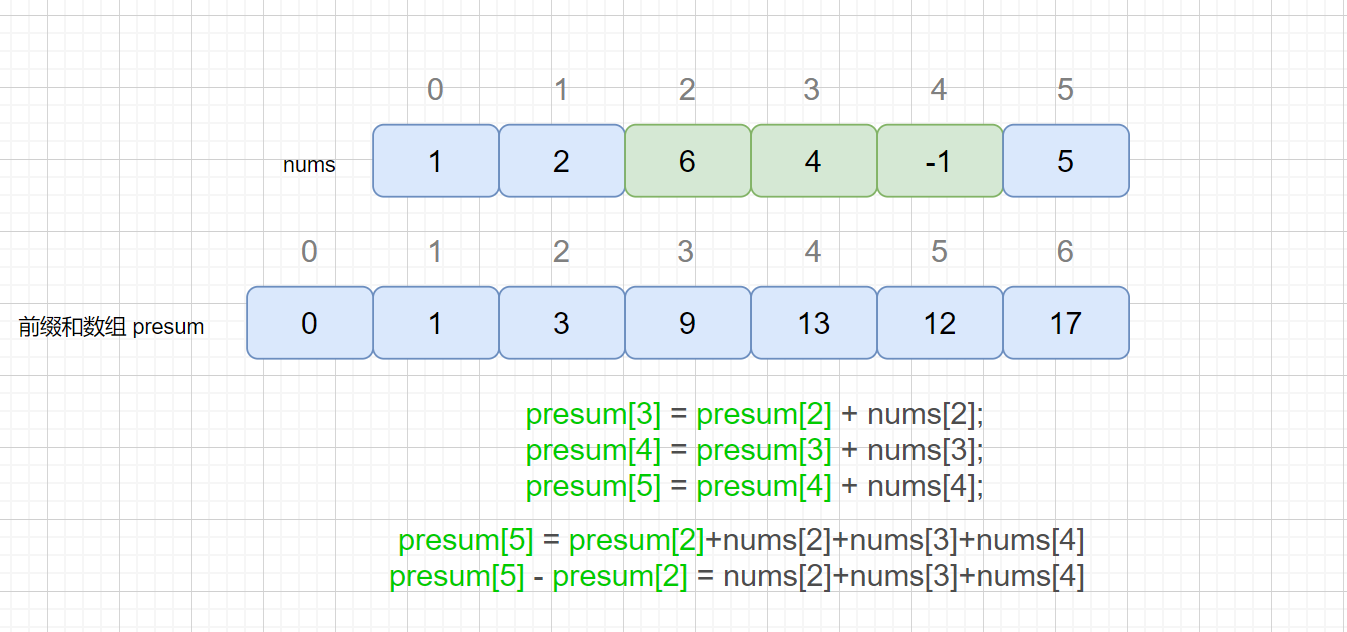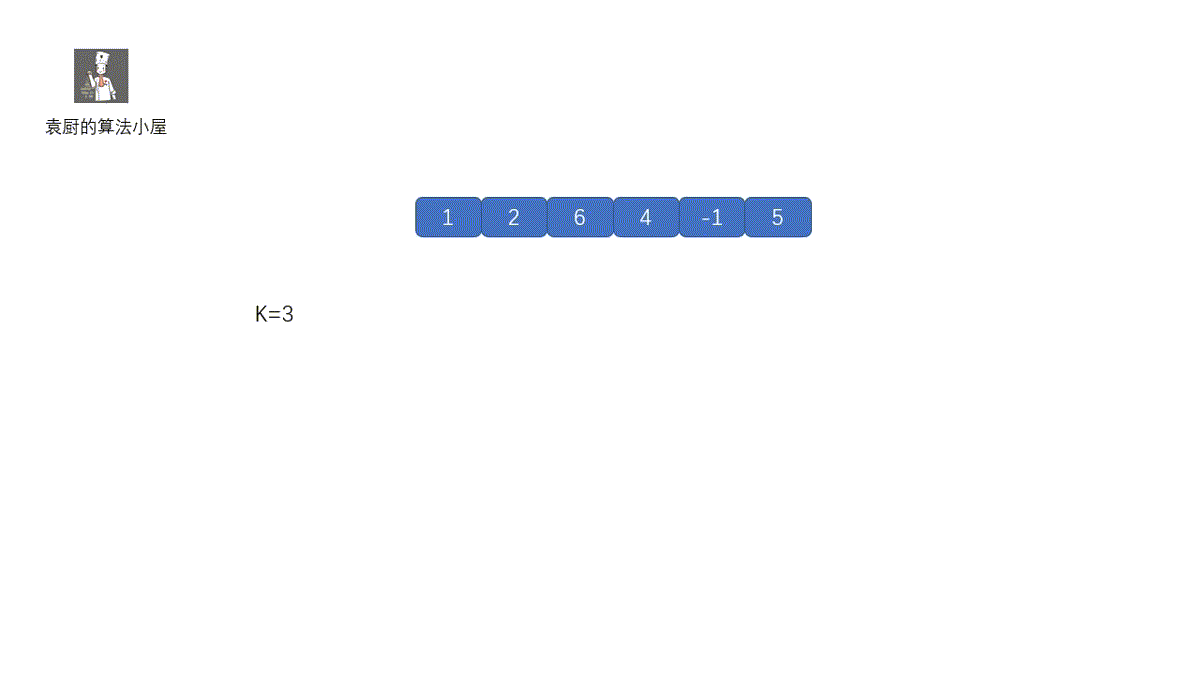mirror of
https://github.com/chefyuan/algorithm-base.git
synced 2024-11-28 06:48:53 +00:00
206 lines
7.6 KiB
Markdown
206 lines
7.6 KiB
Markdown
> 如果阅读时,发现错误,或者动画不可以显示的问题可以添加我微信好友 **[tan45du_one](https://raw.githubusercontent.com/tan45du/tan45du.github.io/master/个人微信.15egrcgqd94w.jpg)** ,备注 github + 题目 + 问题 向我反馈
|
||
>
|
||
> 感谢支持,该仓库会一直维护,希望对各位有一丢丢帮助。
|
||
>
|
||
> 另外希望手机阅读的同学可以来我的 <u>[**公众号:程序厨**](https://raw.githubusercontent.com/tan45du/test/master/微信图片_20210320152235.2pthdebvh1c0.png)</u> 两个平台同步,想要和题友一起刷题,互相监督的同学,可以在我的小屋点击<u>[**刷题小队**](https://raw.githubusercontent.com/tan45du/test/master/微信图片_20210320152235.2pthdebvh1c0.png)</u>进入。
|
||
|
||
#### [560. 和为 K 的子数组](https://leetcode-cn.com/problems/subarray-sum-equals-k/)
|
||
|
||
**题目描述**
|
||
|
||
> 给定一个整数数组和一个整数 k,你需要找到该数组中和为 k 的连续的子数组的个数。
|
||
|
||
**示例 1 :**
|
||
|
||
> 输入:nums = [1,1,1], k = 2
|
||
> 输出: 2 , [1,1] 与 [1,1] 为两种不同的情况。
|
||
|
||
**暴力法**
|
||
|
||
**解析**
|
||
|
||
这个题目的题意很容易理解,就是让我们返回和为 k 的子数组的个数,所以我们直接利用双重循环解决该题,这个是很容易想到的。我们直接看代码吧。
|
||
|
||
```java
|
||
class Solution {
|
||
public int subarraySum(int[] nums, int k) {
|
||
int len = nums.length;
|
||
int sum = 0;
|
||
int count = 0;
|
||
for (int i = 0; i < len; ++i) {
|
||
for (int j = i; j < len; ++j) {
|
||
sum += nums[j];
|
||
if (sum == k) {
|
||
count++;
|
||
}
|
||
}
|
||
sum = 0;
|
||
}
|
||
return count;
|
||
}
|
||
}
|
||
```
|
||
|
||
下面我们我们使用前缀和的方法来解决这个题目,那么我们先来了解一下前缀和是什么东西。其实这个思想我们很早就接触过了。见下图
|
||
|
||

|
||
|
||
我们通过上图发现,我们的 presum 数组中保存的是 nums 元素的和,presum[1] = presum[0] + nums[0];
|
||
|
||
presum [2] = presum[1] + nums[1],presum[3] = presum[2] + nums[2] ... 所以我们通过前缀和数组可以轻松得到每个区间的和,
|
||
|
||
例如我们需要获取 nums[2] 到 nums[4] 这个区间的和,我们则完全根据 presum 数组得到,是不是有点和我们之前说的字符串匹配算法中 BM,KMP 中的 next 数组和 suffix 数组作用类似。
|
||
|
||
那么我们怎么根据 presum 数组获取 nums[2] 到 nums[4] 区间的和呢?见下图
|
||
|
||

|
||
|
||
所以我们 nums[2] 到 nums[4] 区间的和则可以由 presum[5] - presum[2] 得到。
|
||
|
||
也就是前 5 项的和减去前 2 项的和,得到第 3 项到第 5 项的和。那么我们可以遍历 presum 就能得到和为 K 的子数组的个数啦。
|
||
|
||
直接上代码。
|
||
|
||
```java
|
||
class Solution {
|
||
public int subarraySum(int[] nums, int k) {
|
||
//前缀和数组
|
||
int[] presum = new int[nums.length+1];
|
||
for (int i = 0; i < nums.length; i++) {
|
||
//这里需要注意,我们的前缀和是presum[1]开始填充的
|
||
presum[i+1] = nums[i] + presum[i];
|
||
}
|
||
//统计个数
|
||
int count = 0;
|
||
for (int i = 0; i < nums.length; ++i) {
|
||
for (int j = i; j < nums.length; ++j) {
|
||
//注意偏移,因为我们的nums[2]到nums[4]等于presum[5]-presum[2]
|
||
//所以这样就可以得到nums[i,j]区间内的和
|
||
if (presum[j+1] - presum[i] == k) {
|
||
count++;
|
||
}
|
||
}
|
||
}
|
||
return count;
|
||
}
|
||
}
|
||
```
|
||
|
||
我们通过上面的例子我们简单了解了前缀和思想,那么我们如果继续将其优化呢?
|
||
|
||
**前缀和 + HashMap**
|
||
|
||
**解析**
|
||
|
||
其实我们在之前的两数之和中已经用到了这个方法,我们一起来回顾两数之和 HashMap 的代码.
|
||
|
||
```java
|
||
class Solution {
|
||
public int[] twoSum(int[] nums, int target) {
|
||
|
||
HashMap<Integer,Integer> map = new HashMap<>();
|
||
//一次遍历
|
||
for (int i = 0; i < nums.length; ++i) {
|
||
//存在时,我们用数组得值为 key,索引为 value
|
||
if (map.containsKey(target - nums[i])){
|
||
return new int[]{i,map.get(target-nums[i])};
|
||
}
|
||
//存入值
|
||
map.put(nums[i],i);
|
||
}
|
||
//返回
|
||
return new int[]{};
|
||
}
|
||
}
|
||
```
|
||
|
||
上面代码中,我们将数组的值和索引存入 map 中,当我们遍历到某一值 x 时,判断 map 中是否含有 target - x,即可。其实我们现在这个题目和两数之和原理是一致的,只不过我们是将**所有的前缀和**该**前缀和出现的次数**存到了 map 里。下面我们来看一下代码的执行过程。
|
||
|
||
**动图解析**
|
||
|
||

|
||
|
||
**题目代码**
|
||
|
||
Java Code:
|
||
|
||
```java
|
||
class Solution {
|
||
public int subarraySum(int[] nums, int k) {
|
||
if (nums.length == 0) {
|
||
return 0;
|
||
}
|
||
HashMap<Integer,Integer> map = new HashMap<>();
|
||
//细节,这里需要预存前缀和为 0 的情况,会漏掉前几位就满足的情况
|
||
//例如输入[1,1,0],k = 2 如果没有这行代码,则会返回0,漏掉了1+1=2,和1+1+0=2的情况
|
||
//输入:[3,1,1,0] k = 2时则不会漏掉
|
||
//因为presum[3] - presum[0]表示前面 3 位的和,所以需要map.put(0,1),垫下底
|
||
map.put(0, 1);
|
||
int count = 0;
|
||
int presum = 0;
|
||
for (int x : nums) {
|
||
presum += x;
|
||
//当前前缀和已知,判断是否含有 presum - k的前缀和,那么我们就知道某一区间的和为 k 了。
|
||
if (map.containsKey(presum - k)) {
|
||
count += map.get(presum - k);//获取presum-k前缀和出现次数
|
||
}
|
||
//更新
|
||
map.put(presum,map.getOrDefault(presum,0) + 1);
|
||
}
|
||
return count;
|
||
}
|
||
}
|
||
```
|
||
|
||
C++ Code:
|
||
|
||
```cpp
|
||
public:
|
||
int subarraySum(vector<int>& nums, int k) {
|
||
if (nums.size() == 0) {
|
||
return 0;
|
||
}
|
||
map <int, int> m;
|
||
//细节,这里需要预存前缀和为 0 的情况,会漏掉前几位就满足的情况
|
||
//例如输入[1,1,0],k = 2 如果没有这行代码,则会返回0,漏掉了1+1=2,和1+1+0=2的情况
|
||
//输入:[3,1,1,0] k = 2时则不会漏掉
|
||
//因为presum[3] - presum[0]表示前面 3 位的和,所以需要m.insert({0,1}),垫下底
|
||
m.insert({0, 1});
|
||
int count = 0;
|
||
int presum = 0;
|
||
for (int x : nums) {
|
||
presum += x;
|
||
//当前前缀和已知,判断是否含有 presum - k的前缀和,那么我们就知道某一区间的和为 k 了。
|
||
if (m.find(presum - k) != m.end()) {
|
||
count += m[presum - k];//获取presum-k前缀和出现次数
|
||
}
|
||
//更新
|
||
if(m.find(presum) != m.end()) m[presum]++;
|
||
else m[presum] = 1;
|
||
}
|
||
return count;
|
||
}
|
||
};
|
||
```
|
||
|
||
Go Code:
|
||
|
||
```GO
|
||
func subarraySum(nums []int, k int) int {
|
||
m := map[int]int{}
|
||
// m存的是前缀和,没有元素的时候,和为0,且有1个子数组(空数组)满足条件,即m[0] = 1
|
||
m[0] = 1
|
||
sum := 0
|
||
cnt := 0
|
||
for _, num := range nums {
|
||
sum += num
|
||
if v, ok := m[sum - k]; ok {
|
||
cnt += v
|
||
}
|
||
// 更新满足前缀和的子数组数量
|
||
m[sum]++
|
||
}
|
||
return cnt
|
||
}
|
||
```
|